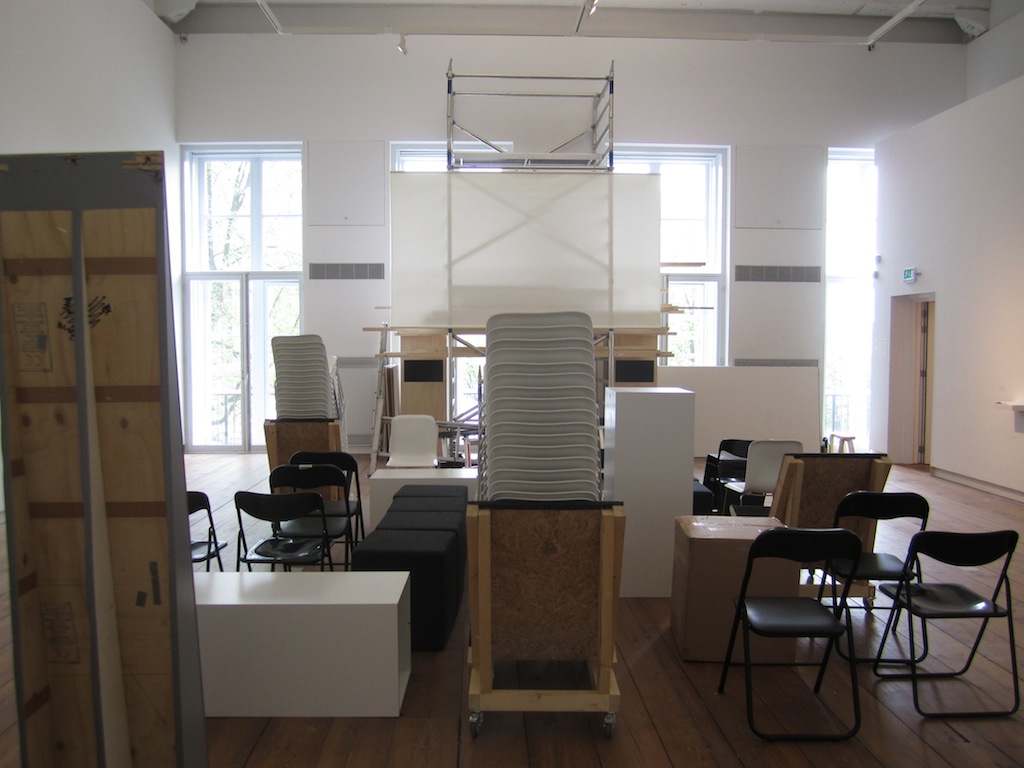
Father, Can’t You See I’m Burning?

Father, Can’t You See I’m Burning?, the group exhibition curated by De Appel Curatorial Programme 2013/2014, lends it title from one of Freud’s famous dream interpretations. In this specific dream, recounted in The Interpretation of Dreams, a father whose son has just died, falls asleep and dreams that his child is standing by his bed asking, “Father, can’t you see I’m burning?”. The father wakes up to find that one of the candles around his dead son’s bed has fallen and begun to burn the child’s arm. Freud, and later Lacan and more recently Zizek, have each analyzed and explained the dream slightly different. But in each reading what lasts is the vividness of the traumatic image of a burning child reprimanding his father that he isn’t aware of his burning.
The exhibition at De Appel borrows this famous sentence to tell different stories relating to institutions, rebellion and “fire” that sometimes overlap and become one but that mostly stay separated. Before delving into these stories and the works in the exhibition, I want to stress that I enjoyed seeing the show. There were strong moments and good works. The overall atmosphere and balance was good. I was positively surprised at certain turns (the room full of stacked furniture and material used during the installation for example, the squid ink work by Robertas Narkus).
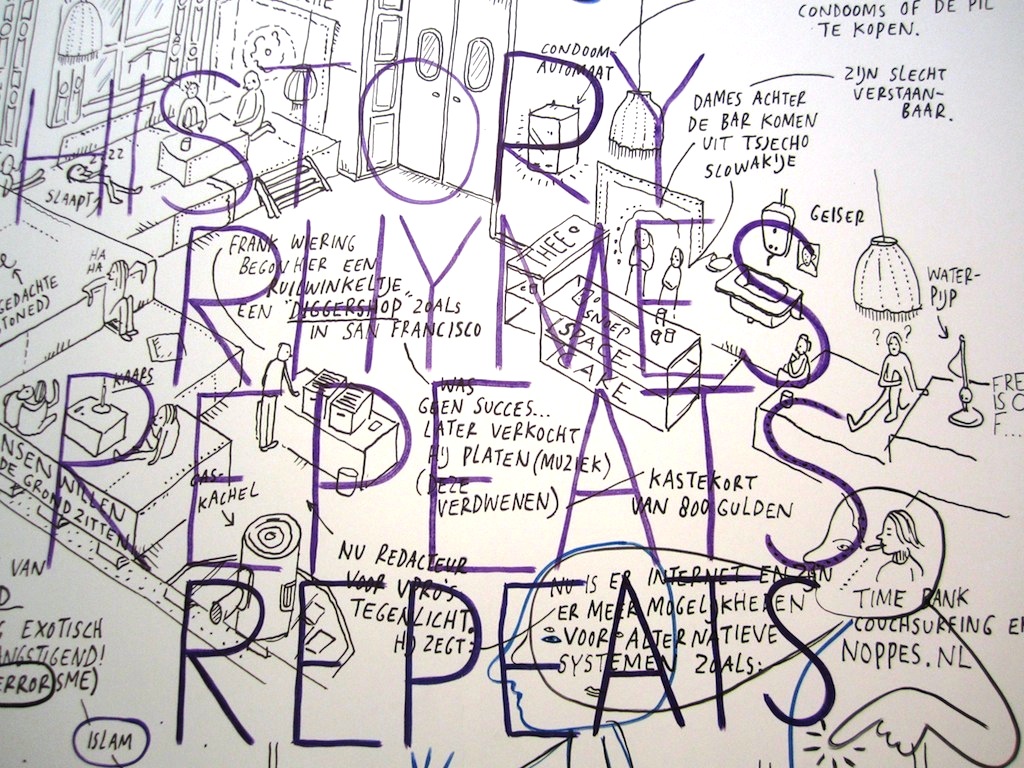
A historical non-event
The six curators of this year’s annual Curatorial Programme end show are Renata Cervetto, Kris Dittel, Lara Khaldi, Emma Panza, Aneta Rostkowska and Kate Strain. A starting point for Father, Can’t You See I’m Burning? seems to have been what the curators call the historical important non-event of the Situationist International (SI) 1959 proposal to then director of the Stedelijk Museum Amsterdam Willem Sandberg to build a labyrinthine structure connecting the inside of the museum to the outside world. Sandberg allegedly responded in favor of the proposal if the SI collaborated with the fire brigade and secured additional financial support. Requests that might sound familiar to most people working with or in institutions today. The SI however withdrew their proposal.
The exhibition touches upon issues of institutional rules and (fire) regulations rather directly with the works by Jan Hoeft for example. He installed in different locations (I could find two) throughout the building drainages that are used in case of a fire to drain extra water. His Surface Drainage (2014) takes on the “extreme nature of fire regulations, and their influence in shaping the physical space of an institution”. Often these fire regulations “become part of the architecture and design of the building” (all citations are taken from the exhibition brochure). This point is almost literally illustrated by his video work Exit Strategy (2014), showing the ubiquitous red emergency hammer (‘In case of emergency break glass’). The labyrinthine structure is suggested at in the show (with another wink to the fire brigade and its influence on how we work, make exhibitions etc) with a fixed routing plan and a new exit strategy out of this routing: the fire escape.
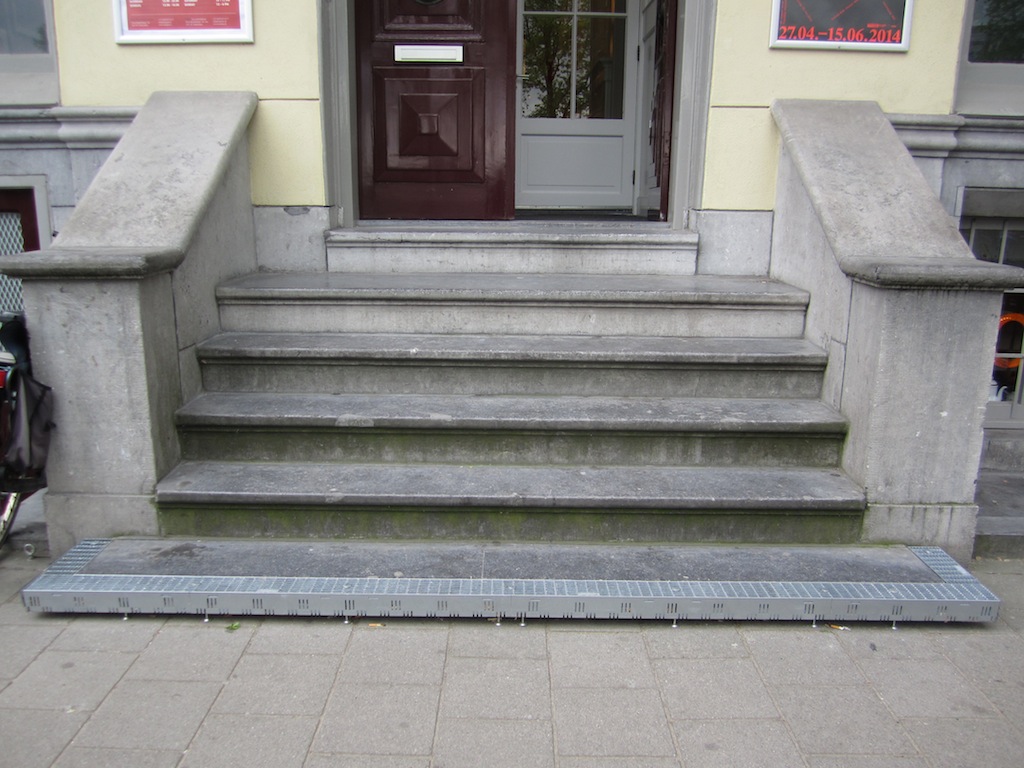
Rules and regulations
Taking this topic of the institution further, the six curators write in their brochure about today’s art institutions being shaped by rules and regulations, external expectations and internal fears, and their wish and aim to not fall into that trap of fulfilling expectations and pre-molded formats. The fact that Father, Can’t You See I’m Burning? is a “project that unfolds in multiple parts: a prelude, an exhibition, a series of events, and a publication”, seems to undermine this claim. The pre-molded formats are all there, including works distributed through a newsletter, spicy biographical details, performances that you may or may not encounter (in my case: not) or works presented/existing online (for example: ART IS A LIE THAT JUST WON’T DIE (2014) by Young-Hae Chang Heavy Industries).
Almost all works in the exhibition relate to institutions in one way or another. There is the Jan Rothuizen drawing Fantasio Again and Again (2013-2014) to which he added a new, more contemporary layer in large blue letters and crude drawings (think “free Wifi”, “Wikipedia”, “commercial society”, a smart phone).
There is the invitation by Ieva Miseviciute to use the skin-colored clay on a pedestal to form a work based on audio instructions: There is no stopping this institution (2014).
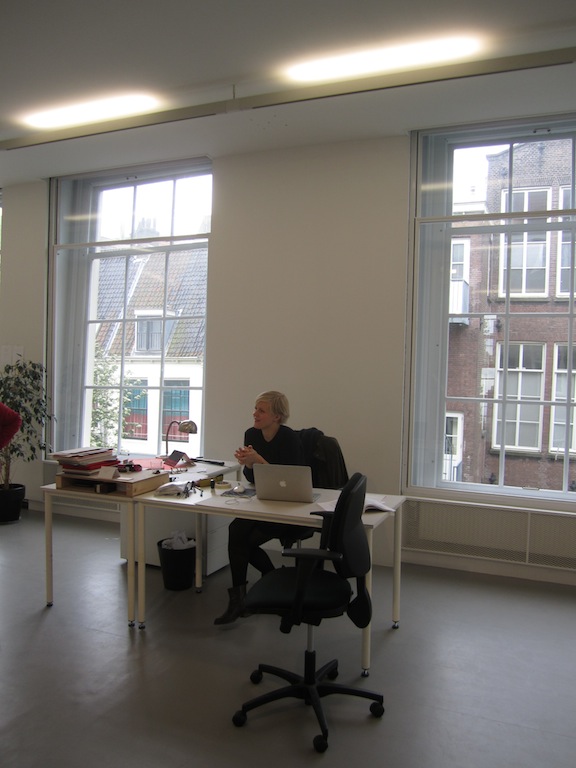
Michael Portnoy positioned artist Rán Flygenring at a desk in De Appel with the task to be The Roaster, the person who would ‘roast’ and ‘improve’ all the other works in the show. A funny side effect of this project is that through the drawings and notes by Flygenring, I was able to get some idea of the works I missed (the newsletter work or the ad-hoc performance works, for example).
Sarah van Lamsweerde in turn took on the institution of the auction by selling parts of a story to the highest bidder in Tell/Sell, a common story (2014), a work that seemed to echo the auction performance by Potential Estate in which they too sold parts of a story to the highest bidder.
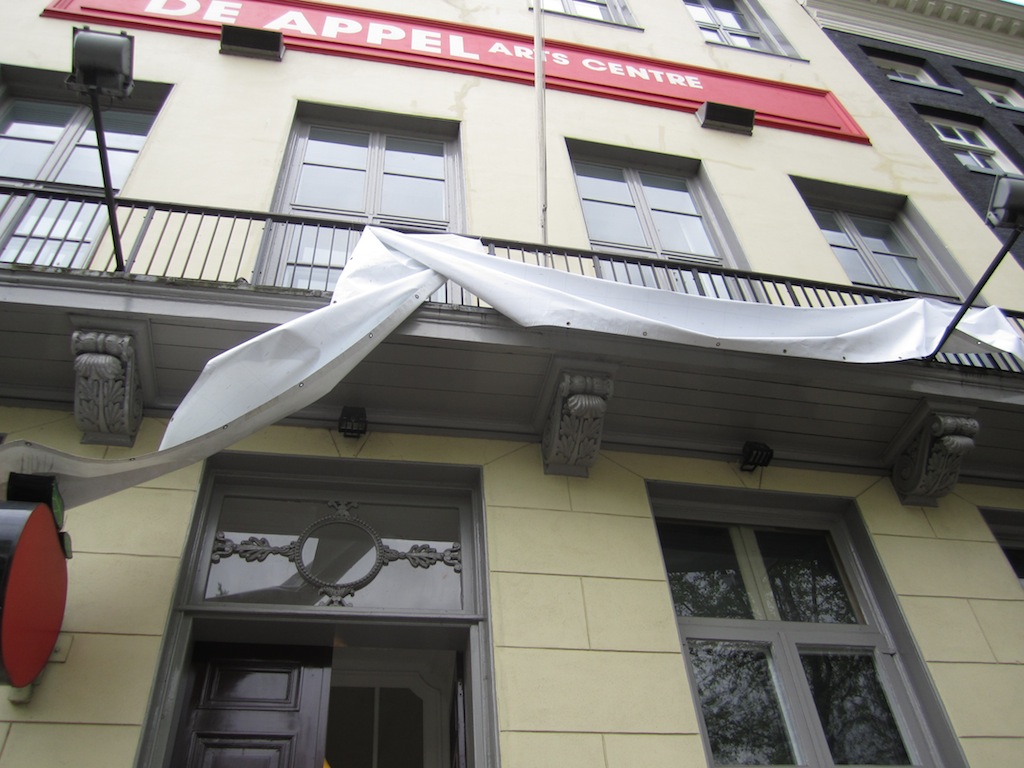
More cynical about institutions are the works by Reinaart Vanhoe. His Banner (2012) hangs partly attached to the façade of De Appel, flapping furiously in the wind and being anything but a great way to advertise. This is anti-publicity if anything. His www.kunsthallebeijing.org (2011) is a fictional art institution existing only online and equally careless and sloppy. Vanhoe “consciously resists and mocks the external pressure for an artist to be professional” the brochure reads. You can say that again.
Two performance works that I never encountered (or could not encounter) dealt rather directly with the exhibition and its inception itself. Krõõt Juurak dealt with the “internal tensions between the curators of the exhibition” in her Internal Conflict (2014), an ongoing performance by the participants of the Curatorial Programme. We can only imagine the disagreements, the tensions, and the diverging ambitions of these (or any) six young curators having to work together on one single show. Katarina Zdjelar created an unannounced and ongoing performance in which performers roam the exhibition and perform a partly authored, partly improvised script dealing with the references of this exhibition, the artworks as well as gossip and rumors.
Rebellion and fire
Another storyline running through Father, Can’t You See I’m Burning? is that of “skepticism towards a certain legacy of rebellion that we have inherited. It is the legacy of non-compliance”. The curators rebel against their “patronizing fathers” and their “misguided radicalism”. They do not want to be anchored down by this legacy. So if it is not "the aggressive fire of artistic activism" that is burning here, which fire is? It is neither “the ethereal fire of beauty and sheer formalism whose only use is to keep the art market simmering. And it certainly is not a temporary glaze of fireworks – a mesmerizing spectacle aimed to dazzle.” Rather, the fire they are starting is a “material and sensual fire. A fire of alchemy, not chemistry.”
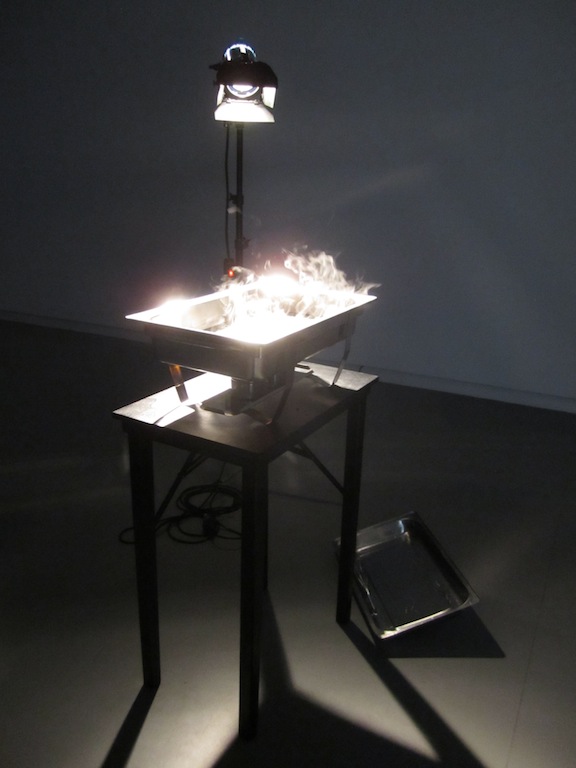
The alchemistic fire is burning only sporadically in the exhibition and most prominently in the work Turbulence 3 (2014) by Robertas Narkus. In a theatrical setup a pan of black squid ink is slowly bubbling and releasing fumes and smells that take on beautiful cloudy shapes. His performance work DVD (2013–2014), also known as ‘the flying belly piece’, promises to be equally mysterious but was not being performed during my visit.
Fire, but of a less mysterious and transmutative kind (the brochure promises the visitor a “fantasy of transmutation, a transmutative fantasy”. Transmutation is the key to alchemy; it is a highly complex and subjective process in which base materials are thought to be able to transform into gold), is present in other works as well. The aforementioned works by Hoeft, the use of the word “roaster” by Portnoy, the fire escape routing but most explicitly in the two works by Marinus Boezem: Paper Events (1967–1969) and If you’d like to see this photo in colors, burn it (1967–1969). Paper Events consists of a booklet reduced to ashes and presented inside a plastic bag. This shape and manifestation of the work is the result of following the instructions as dictated within the now burnt book.
The second work, If you’d like to see this photo in colors, burn it, is now framed. The instructions never carried out and the work never actualized. This feels like an almost impossible contradiction to the fact that the curators wanted to resist rules, regulations, prescribed formats of institutionalization, wanted to rebel against our father and wanted to run wild rather than follow the beaten track. A conceptual work being framed is clearly not the fire of alchemy being kept alive but the one that is keeping the “art market simmering”.
The fire that the curators refer to could have burned so much harder, could have been so much more painful, as in that famous dream analyzed by Freud. At moments the intensity is there, at other moments you feel it slipping away.
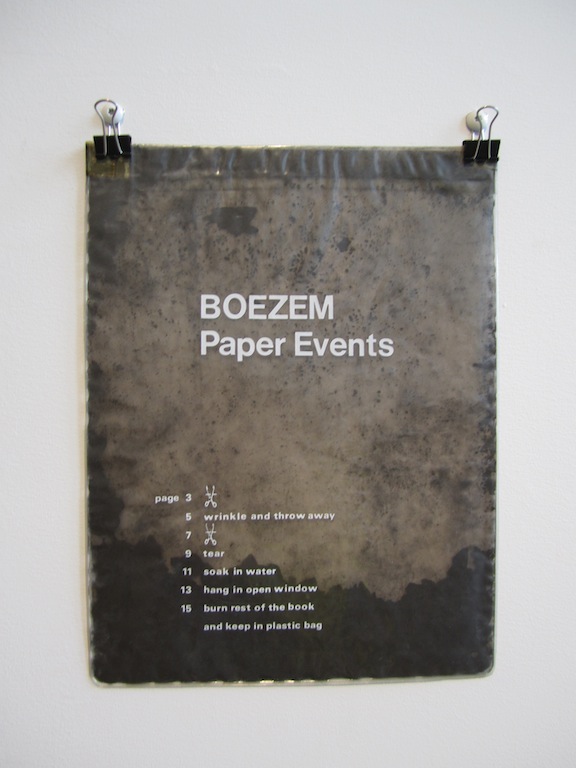
Father, Can’t You See I’m Burning?
De Appel Arts Centre
April 27 till June 15, 2014
Prins Hendrikkade 142
1011 AT Amsterdam
Maaike Lauwaert


